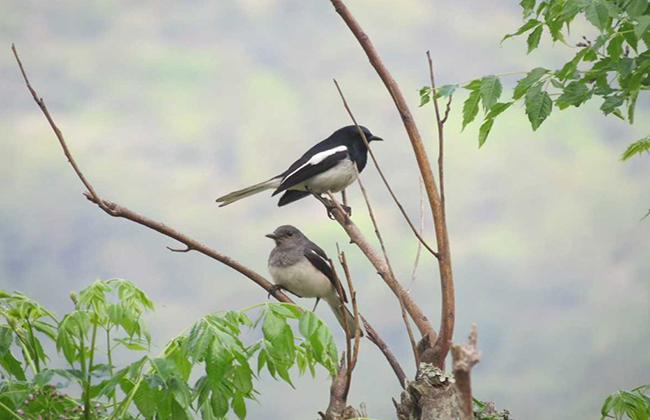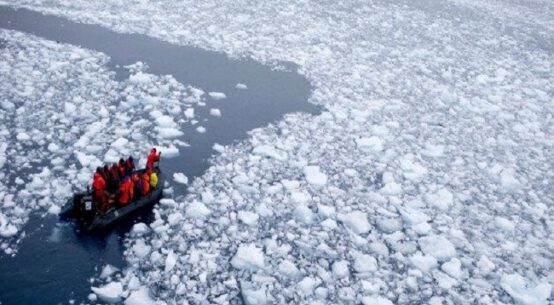
In pre-monsoon the heat of May, five teenage boys used a rope with knots in it to scale a wall and enter the national botanical gardens in Dhaka, the capital of Bangladesh. They dropped down next to a big pond surrounded by foliage encircled by a pedestrian path. Beyond the walls, the youths were fruit sellers, hawking guava, mango and seasonally fresh fruit on packed city buses that transport Dhaka’s working-class residents. They come to the gardens when it is just too hot, or the air quality too poor, to ride the buses.
The National Botanical Garden costs 20 taka, about $0.17, to enter, but the rope allows Junayed, 17, and Akash, 18, to enter whenever they please without paying.
“We can come over the wall, and we can come through the gate too. That is why we come here,” they said.
As they relaxed beneath the trees, staring across the pond, the boys relished the relative quiet of the preserved space. Often, they visit in the morning or the evening with their other friends; sometimes they come twice a day.
Junayed and Akash said that beyond the walls, the amount of green space has decreased during their lives. Land once covered in trees, shrubs and grass now hosts apartments and stores.
“There were fields and we played there,” one of the teens said. There used to be ponds in their area, but they were filled in to create ground for new construction.
In Dhaka and other cities in Bangladesh, climate change and dense infrastructure make extreme urban heating a stark reality for residents. In a 2021 study on land surface temperatures and land cover changes published in the journal Earth Systems and Environment, maximum land surface temperature increased by 6.43 degrees Celsius between 1993 and 2020.
According to World Population Review, Dhaka is growing roughly 3% a year and is one of the most densely populated cities in the world at 99,000 people per square mile. A massive heat island on what was once a watery river delta, Dhaka’s planners face a striking challenge: how to avoid cooking its roughly 24 million residents.
Conventional wisdom about heat islands — urban areas that are hotter than nearby rural areas because of the way the built environment absorbs and reemits heat from the sun — suggests that cities work to restore parks, trees and vegetation to keep things cool. But scientists and urban planners have found that another approach is even more beneficial to Dhaka’s predicament: conserving wetlands.
Satellite imagery of Dhaka reveals a dizzying tangle of rivers, lakes and arterial canals, called khals. The city is ringed by six major rivers, part of the second-largest river system in the world. Building here has long required covering or filling in waterways.
Urban heat intensity
Sayeed Ahmed Choudhury is the former head of the climate division of the Bangladesh Meteorological Department. For years, his job was to monitor climate conditions in Bangladesh. That work has been complicated by the impact a sprawling city has on the local climate, and by the changing global climate caused principally by burning fossil fuels, he said.
In the last 10 years, there have been 172 heat waves in Dhaka, he said, pinning some of the blame on urban growth. Since Bangladesh gained independence from Pakistan in 1971, people have come to the city seeking jobs and security. It has grown from 1.5 million to 24 million people, with climate change and a growing economy keeping the growth rate at a steady pace of 3.5% in recent years. “Nowadays we have lot of development,” Choudhury said.
But extreme heat is making Dhaka a difficult place to live.
During this year’s pre-monsoon season, which is March through May, Bangladesh was hit with the longest heat wave in the nation’s history. The average temperature in April was 36° Celsius (97° Fahrenheit). Temperatures reached more than 40°C (104°F) for more than three days in a row. Schools across the country shut down and millions of students were told to stay home.
Paving natural spaces
For the last several decades, Dhaka has sprawled and reached for the sky. The built-up area in the city increased by 67% from 1993 to 2020, according to the 2021 study.
That construction came at a tremendous loss of natural space and the cooling properties it offered. Nearly 88.24% of the healthy vegetation and a total of 56% of the green spaces were lost between 1989 and 2020, according to a 2022 study by Nowshin Nawar, published in the journal Environmental Challenges.
In roughly the same period, Dhaka suffered a massive loss of wetlands, severing the connectivity of water bodies and leaving wetlands degraded and isolated. About 72% of Dhaka’s wetlands were lost between 1988 and 2016, according to a 2018 study by the Bangladesh Institute of Planners.
That loss, the study concluded, will continue to accelerate the warming of Dhaka’s microclimate.
While heat island research has often focused on the impact of urban trees and parks, Choudhury’s work points to wetlands and water bodies as the prime heat mitigation features.
Water can absorb and hold more heat than solid bricks and concrete, and so it regulates air temperature better, he said. Covering natural surfaces dampens this cooling effect.
When the wetland area is bigger, the temperature is “comparatively lower” Choudhury said
Conserving the wetlands
Protecting existing wetlands is central to efforts to moderate heat despite unregulated growth in Khulna, the third-largest city in Bangladesh.
“We are trying to build a more sustainable city, but not everything is in our hand,” said Abir Ul Jabbar, the chief planning officer for the Khulna City Corporation. Jabbar’s job is to keep Khulna organized and its buildings safe.
But as unplanned building projects of all kinds spring up around Khulna, the city government struggles to keep them in line with the building practices they aspire to implement.
As climate change and economic challenges drive people out of their homes in coastal regions, they flow into the larger cities like Khulna and Dhaka.
“There is limited land and limited resources,” Jabbar said. But more people in areas of uncontrolled sprawl and slums increases the intensity of extreme heat.
To combat urban heat, the city is pursuing both large and small projects to protect waterways and urban greenery.
“We have to reduce the heat, so we will preserve 23 ponds and lakes,” Jabbar said, describing one of the city’s landscape-level goals. Khulna’s smaller-scale projects target individual actions. “We trained up 25 people who are now experts on rooftop gardening,” Jabbar said.
Khulna’s strategy is similar to the approach Choudhury would like other Bangladesh cities to embrace. Green spaces are important, and they need to be emphasized and protected, but water bodies, he said, are the “prime factor” in heat mitigation.
In their study on wetlands, the Bangladesh Institute of Planners was emphatic: “To control the warming of microclimate and solve the waterlogging problem of Dhaka city, conservation of existing wetlands is must.”
(This article was republished from Mongabay under Creative Commons License)
Riley Comstock is a student at University of Montana, Missoula, Montana, United States


